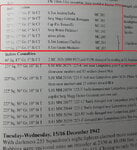Here are some excerpts from Shores, randomly taken from about 40 pages in the middle of MAW III, covering the time period from Nov 1942 - Jan 1943. I went through and circled Italian fighter losses and claims - in red for MC.202 and blue for all the older types. In total I count ~40 mentions of the MC.202, one mention of a G.50 and one of an MC.200, the latter of which was on some kind of special convoy escort.
I don't expect this to prove anything but I am showing you what I see in the operational history, it's almost all MC 202 and German fighters (which at this stage of the war are all 109G-2 and G-4, or Fw 190s, with a few F-4 remaining)

Nov 1942 - 5 x MC. 202 lost, 1 x G.50 lost

22 Nov 1942 - 1 x MC.202 lost, 4 x MC.202 made claims

30 Nov 1942 - 2 x MC.202 made claims, 1 x MC.202 lost in accident

2 Dec 1942 - 1x MC.202 made claims, 1 x MC202 lost and 5 x MC.202 damaged, 1x MC. 200 lost

15 Dec 1942 - 7 x MC.202 made claims, 2 x MC.202 damaged by strafing

29 Dec 1942 - 3 x MC 202 made claims

Jan 1943 - 2 x MC.202 made claims

8 Jan 1942 - 2 x MC.202 made claims, 1 x MC.202 crash landed

11 Jan 1943 - 3 x Mc 202 made claims, 1 x MC.202 shot down, 1 x MC.202 damaged

11 Jan 1943 1 x MC.202 damaged landing - this one also mentions that a P-40 piot from 33FG (2nd Lt Scholl) shot down and killed Oblt Heydric, commander h of II./KG 51 when the latter got on the tail of his flight leader. German records confirmed the loss which I also confirmed in another couple of sources.
I don't expect this to prove anything but I am showing you what I see in the operational history, it's almost all MC 202 and German fighters (which at this stage of the war are all 109G-2 and G-4, or Fw 190s, with a few F-4 remaining)

Nov 1942 - 5 x MC. 202 lost, 1 x G.50 lost

22 Nov 1942 - 1 x MC.202 lost, 4 x MC.202 made claims

30 Nov 1942 - 2 x MC.202 made claims, 1 x MC.202 lost in accident

2 Dec 1942 - 1x MC.202 made claims, 1 x MC202 lost and 5 x MC.202 damaged, 1x MC. 200 lost

15 Dec 1942 - 7 x MC.202 made claims, 2 x MC.202 damaged by strafing

29 Dec 1942 - 3 x MC 202 made claims

Jan 1943 - 2 x MC.202 made claims

8 Jan 1942 - 2 x MC.202 made claims, 1 x MC.202 crash landed

11 Jan 1943 - 3 x Mc 202 made claims, 1 x MC.202 shot down, 1 x MC.202 damaged

11 Jan 1943 1 x MC.202 damaged landing - this one also mentions that a P-40 piot from 33FG (2nd Lt Scholl) shot down and killed Oblt Heydric, commander h of II./KG 51 when the latter got on the tail of his flight leader. German records confirmed the loss which I also confirmed in another couple of sources.
Last edited:
